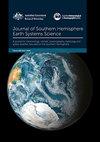澳大利亚森林大火的无缝气候变化预测和季节性预测
IF 3.6
4区 地球科学
Q1 Earth and Planetary Sciences
引用次数: 15
摘要
火灾天气条件的时空变化基于不同的数据集,采用一致的方法来帮助实现不同时间尺度上的无缝服务。这里展示了关于这方面的最新研究,包括对本世纪未来几年的气候变化预测、多周到季节性提前期的预测以及基于观测的历史气候记录。气候预测是根据极端指标提出的,其结果显示为个别季节。作为澳大利亚的一项新能力发展,这里展示了火灾天气条件的季节性预测系统。为了产生更加无缝的预测集,数据集基于分位数-分位数匹配进行校准,以与基于观测的数据集保持一致性,包括帮助为模型预测提供有关极值的详细信息(演示极值的分位数匹配方法)。讨论了影响条件可预测性的因素,包括预先存在的燃料水分、大尺度变率模式、平流层突然变暖和气候趋势。讨论了2019-2020年夏季极端火灾季节,并举例说明了如何使用这套校准的火灾天气数据集,包括提前几个月向消防机构提供的长期预测。这些火灾天气数据集现在以一致的形式提供,涵盖1950年以来的历史记录,未来几个月的长期预测以及整个本世纪的未来气候变化预测。跨不同时间尺度的无缝服务旨在加强长期规划能力和气候适应工作,从而增强抵御自然灾害的能力和减少灾害风险。本文章由计算机程序翻译,如有差异,请以英文原文为准。
Seamless climate change projections and seasonal predictions for bushfires in Australia
Spatio-temporal variations in fire weather conditions are presented based on various data sets, with consistent approaches applied to help enable seamless services over different time scales. Recent research on this is shown here, covering climate change projections for future years throughout this century, predictions at multi-week to seasonal lead times and historical climate records based on observations. Climate projections are presented based on extreme metrics with results shown for individual seasons. A seasonal prediction system for fire weather conditions is demonstrated here as a new capability development for Australia. To produce a more seamless set of predictions, the data sets are calibrated based on quantile-quantile matching for consistency with observations-based data sets, including to help provide details around extreme values for the model predictions (demonstrating the quantile matching for extremes method). Factors influencing the predictability of conditions are discussed, including pre-existing fuel moisture, large-scale modes of variability, sudden stratospheric warmings and climate trends. The extreme 2019–2020 summer fire season is discussed, with examples provided on how this suite of calibrated fire weather data sets was used, including long-range predictions several months ahead provided to fire agencies. These fire weather data sets are now available in a consistent form covering historical records back to 1950, long-range predictions out to several months ahead and future climate change projections throughout this century. A seamless service across different time scales is intended to enhance long-range planning capabilities and climate adaptation efforts, leading to enhanced resilience and disaster risk reduction in relation to natural hazards.
求助全文
通过发布文献求助,成功后即可免费获取论文全文。
去求助
来源期刊

Journal of Southern Hemisphere Earth Systems Science
Earth and Planetary Sciences-Oceanography
CiteScore
8.10
自引率
8.30%
发文量
0
审稿时长
>12 weeks
期刊介绍:
The Journal of Southern Hemisphere Earth Systems Science (JSHESS) publishes broad areas of research with a distinct emphasis on the Southern Hemisphere. The scope of the Journal encompasses the study of the mean state, variability and change of the atmosphere, oceans, and land surface, including the cryosphere, from hemispheric to regional scales.
general circulation of the atmosphere and oceans,
climate change and variability ,
climate impacts,
climate modelling ,
past change in the climate system including palaeoclimate variability,
atmospheric dynamics,
synoptic meteorology,
mesoscale meteorology and severe weather,
tropical meteorology,
observation systems,
remote sensing of atmospheric, oceanic and land surface processes,
weather, climate and ocean prediction,
atmospheric and oceanic composition and chemistry,
physical oceanography,
air‐sea interactions,
coastal zone processes,
hydrology,
cryosphere‐atmosphere interactions,
land surface‐atmosphere interactions,
space weather, including impacts and mitigation on technology,
ionospheric, magnetospheric, auroral and space physics,
data assimilation applied to the above subject areas .
Authors are encouraged to contact the Editor for specific advice on whether the subject matter of a proposed submission is appropriate for the Journal of Southern Hemisphere Earth Systems Science.
 求助内容:
求助内容: 应助结果提醒方式:
应助结果提醒方式:


